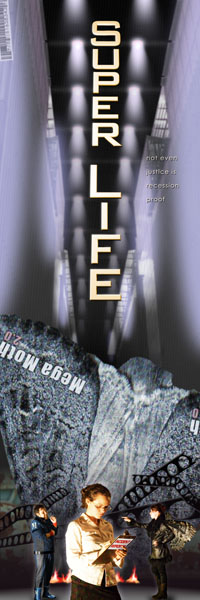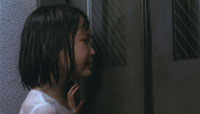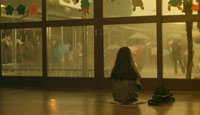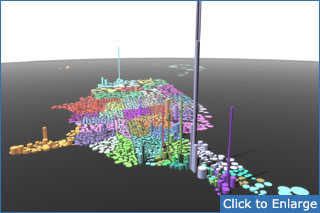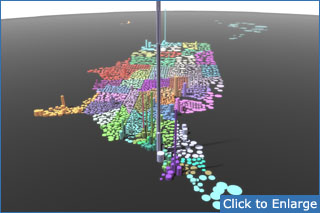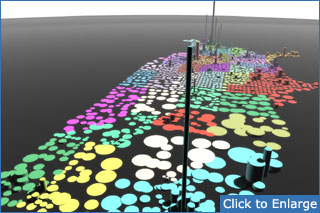From the team that brought you “We Heart Superman”
Super Life: Visual Test #1
Grammy Rasmussen
My grandmother passed away on January 14. I brought a microphone and sat down with her back in 2002, then shot some 16mm film on Friendship Long Island and edited a short. Here is that film:
Five Underused Horror Tropes
And properties that make interesting use of them.
1. Frankenstein Creations: Powerful, perhaps immortal confusions of once-dead human parts reanimated by Dr. Frankenstein’s (always) secret method. Not to be overly confused with James Whale’s 1931 film with its constricted, single-location plot, dim bolt-necked creation, and memorable use of Nicola Tesla-inspired electrical equipment as the (revealed) method of cell reanimation.
Franken Fran: A manga series about a loveable but somehow unmistakeably monsterous patchwork girl who inhabits a mansion full of equally bizarre creations, “helping” people as she sees fit, and awaiting the return of her creator.
2. Dopplegangers: Classically, a mute apparition of oneself that appears to warn against impending danger.
Arcana: Another manga, slow to start, in which a girl matching no missing person’s report is found by the police, and by her ability to see ghosts proves useful in investigating a series of brutal murders.
3. Former Tenants: Beings who inhabited the Earth long before humans, and who want their world back.
The short stories of H.P. Lovecraft: Lovecraft lived in the era when man was pushing into the final dark corners of the map. His dominant theme was a fear that the dark corners would push back. The double-switch Lovecraft plays in “At the Mountains of Madness” is particularly impressive. (Cthulhu, despite his fame, is a relatively minor player.)
4. Sirens: Beautiful female creatures, often with the aspects of seabirds, who lure men (and women?) to a watery death with an irresistable song.
There is a Japanese survival horror videogame series called “Siren,” but it appears to have very little to do with the western myth.
5. The Motif of Harmful Sensation: Related to the siren, a broader term for the idea of a piece of sensory input that can cause a physical effect on the victim. (Well explained in the finest deleted Wikipedia article I’ve ever come across.)
BLIT: David Langford’s remarkable short story revolves around the discovery of a class of images that “crash” the human brain, killing anyone who views them.
The Sci Fi Channel
Dark Water: Thoughts on Horror
I’m beginning to wonder if Dark Water is Hideo Nakata’s masterpiece. It drills down through the cosmic terror of The Ring to something far more intimate: The fear of abandonment. We see the child’s fear of abandonment not only in the repeated scenes of one being left after the close of school, but in the adult characters eyes as, by proxy, they’re forced to re-experience its gnawing toxicity. The water, the intrusion of darkness into the rainsoaked day, and the intrusion of water into the spaces and times it’s not meant to be in all mirror that forgotten feeling. The breaking of a child’s trust in the parent, which is also the child’s trust in the world, is a trauma that even adulthood can’t banish forever. Watching an imperfect single mother struggle to hold her own crumbling world together against that invading fear is heart-wrenching. All horror is psychological horror, crystalized in the moment of realizing one has been wrong. Dark Water is Nakata’s most emotionally draining film and that, I believe, may make it his finest horror film. Hell is being alone forever.
The Man With the Pointy Hat
"In the current storyline, there's a lot that I don't agree with, and I made this very clear to everybody within shouting distance . . . As an executive producer as well as a writer, I've sometimes had to insist that my writers make changes that they did not want to make, often loudly so. They were sure I was wrong. Mostly I was right. Sometimes I was wrong. But whoever sits in the editor's chair, or the executive producer's chair, wears the pointy hat of authority, and as Dave Sim once noted, you can't argue with a pointy hat.
"So at the end of the day, all one can do is try to do the best one can with the notes one is given, and try to execute them in a professional way -- because who knows, the other guy may be right . . . ."
— J. Michael Straczynski
2:35
“And sometimes there’s no one there. And there isn’t going to be.” — Michael Ventura, Shadow-Dancing in the U.S.A.
Wall-E is the perfect expression of what it’s like to meet a modern woman. She’s sophisticated, sleek, brilliant, beautiful, focused — and something of a pyro. You’re a bit clever perhaps, but otherwise the only thing to recommend you is that you’ve somehow managed to survive this long.
Windy City: “To A Skyfarer”
Previously posted is a poem for the third draft of my feature screenplay “Windy City.” Draft two borrows from a song by VNV Nation, but I thought it best to write something of my own as a backup. Here are the lyrics as they appear in situ:
A gust carries some equipment away and tugs at the cable. There is a loud SNAP. The workman turns his lamp away from the locks, toward the cable and finds -- a slowly lengthening CRACK.
WORKMAN
CABLEFALL! CABLEFALL!
The cable SNAPS. Half of it CRASHES across the trolley tracks, wiping them away like chalk marks. The other half SLAMS back into the building. The upper floor windows EXPLODE, raining big chunks of plastic on the old workman and his crew.
WORKMAN
DOWN! EVERYONE DOWN!
INT. HOTEL - LOBBY - EARLY MORNING
A low, distant BOOM. The power flickers. Nadine and her sister Ashur are crammed onto a cot in the dark lobby with the other refugees. The building GROANS in the wind. Ashur is too frightened to sleep. Nadine begins to stroke her hair.
NADINE
(sings)
Morning clouds in disarray/
Bright and cold, this is your day/
Ten points off the rising sun/
Tell me why I feel this way?
Tell me what you've been and done/
Silhouette in solid space/
Future's half-forgotten face/
Stillness grudgingly withdrawn/
Far off engines mutter dawn/
Slow to wake and slow to thaw/
You'd become my paragon/
Hope that time could not withdraw/
Gone too long, returned too soon/
Stowed and moored by afternoon/
Scrambling spotters, busy clerks/
'Til this evening's fireworks/
Dancing through the final song/
Rubbing hair and other perks/
Heart ungimbaled, stomach wrong/
Ship returning, fortunes won/
Voyage ended, and begun/
Ashur sleeps.
“To A Skyfarer”
..-. — .-. .. .-. .- —
Morning clouds in disarray
Bright and cold, this is your day
Ten points off the rising sun
Tell me why I feel this way?
Tell me what you’ve been and done
Silhouette in solid space
Future’s half-forgotten face
Stillness grudgingly withdrawn
Far off engines mutter dawn
Slow to wake and slow to thaw
You’d become my paragon
Hope that time could not withdraw
Gone too long, returned too soon
Stowed and moored by afternoon
Scrambling spotters, busy clerks
‘Til this evening’s fireworks
Dancing through the final song
Rubbing hair and other perks
Heart ungimbaled, stomach wrong
Ship returning, fortunes won
Voyage ended, and begun
Puerto Rico and Housekeeping
Every large project, especially in computer graphics, involves certain long, tedious, repetitive tasks that would only be noticed in the finished product if absent. On Marboxian I nicknamed this type of work “housekeeping.”
In the case of the Population Map, the latest example is Puerto Rico. If given statehood, Puerto Rico would be our 27th largest state, falling between Kentucky and Oregon. It’s the only United States territory with a significant population — much less that of an average state — which is why I’ve chosen to include it — late — in the otherwise completed map.
The tedium comes from not having a .bna file for the 78 municipios of Puerto Rico, which I could use with my standard script to determine their geographic coordinates. Instead, I’ve had to manually enter each into the Open Street Map and copy their URLs to a table.
Next I’ll rewrite the script to break the URLs apart into decimal coordinates, but that’ll be brain work, comparatively.
In the meantime, there’s cookies to make.
From a Night I Couldn’t Sleep
To judge us by our television, every American lives in either New York City, Los Angeles, or an ideal, sepia-toned Midwest. No one lives in a rundown area of Tuscaloosa. No one is from August, ME. There are no Canadians. No hippies survive who haven’t sold out or gone batshit. Everyone is upper-middle-class.
Being single indicates a deep, remedial personal failing. No one is vague about their relationships. Your 20s are nothing but sex, sex, sex. Your 30s are for having babies.
Every house is decorated. Everyone shops at Ikea. Men wear layered shirts. Big hair and pornstar makeup are “in.”
All Asians are smart. No Indians are married. American Blacks are either smart, married (and upper-middle-class) or shooting at each other. There are no Blacks from other countries. No one has ever seen a Philippino. Blue collar people are honest but not very bright, and of no particular importance unless you’re in danger.
Everyone knows one gallery artist, and one architect. Faith is absolute and uncomplicated. Sexuality is binary, conscious, and fixed, even if you’re a teenager. No one has to consider health insurance. No one considers abortion. Considerate people are either doormats or substitute mothers. Everyone takes taxis.
Crime rates are rising. America is full of pedophiles. All Muslims are moral absolutes. Everyone knows exactly what to do at all times, they’re just not sure they have the courage to do it. This is America on television.
I’d like to change all of this. I hope you do too.
Review: “Dead Awake”
Steven “No You’re Thinking of Billy” Baldwin is a dead-to-the-world insomniac somnambulist. He also plays one in this film. Deep in Canadian Chicago, the Born Again Baldwin has been accused of murder — and all ridiculously improbable signs point to same! A C-list cast works heroically to make Steven look almost competent amidst their shrill overacting. The screen fairly pops with references to trannies, porn theatres, MMFF, midgets, dirty old men, animal abuse and leather-clad lesbians. Despite these apparent advantages, and despite padding fifteen minutes of plot with an hour of bad (“clever?”) dialogue, it makes little satisfying sense in the end. (I have a theory that the film was designed to ritualistically cleanse Steven of his pre-twiceborn/ongoing excesses.) Don’t miss Michael Ironside playing Michael Keaton playing Beatlejuice playing Jack Nicholson playing R. P. McMurphy in One Flew Over the Cuckoo’s Nest as… probably another thing Steven’s been trying to swear off. Dead Awake is an incoherent hour and a half with a five drink minimum — this is truly what it’s like to be a Baldwin.
New Population Map Images
Work on the Population Map continues. Below are some test renders from last night. Click for high-resolution images.
The Animation:Master project file is 5.5MB in size, culled from about 7.5MB of data. Some of the random colors chosen by the script make neighboring states hard to distinguish, which will be corrected in jEdit with find/changes. The enormous Yukon/Koyukuk Census Area in Alaska, with an average of one person every 22.5 square miles, is so close to the ground plane that it’s causing the software to glitch. The fill lighting is perhaps a bit too strong while facing west, and the key a bit dingy overall.
Griping aside, this project is coming along well in my opinion.
Moleskin Notes
These were my original scribbles for the population map project. I try to work as much out on paper as I can before moving to the computer.
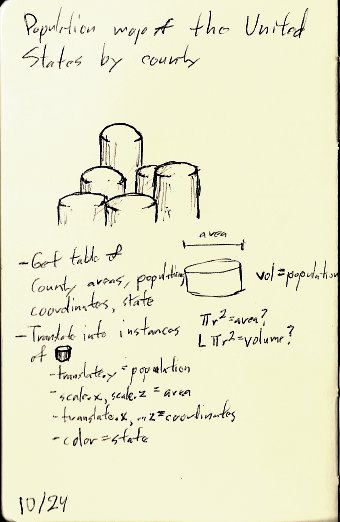
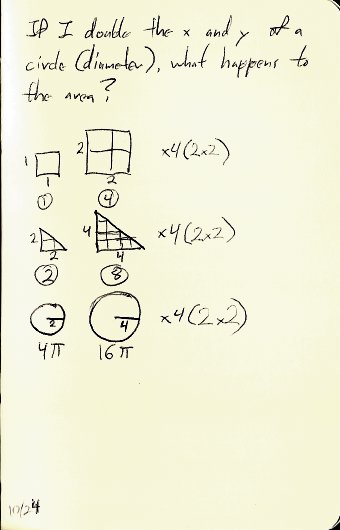
Fun With Data
I started work on a project a little while ago, and it’s probably past time I started blogging it. My intention was to produce a population map of the United States, county by county — essentially, a map of the country’s other topography.
Each cylinder represents one county or equivalent (e.g. an independent city, Louisian parish, or Alaskan census area). The circular area represents the land area, the height its population density, and the volume of each cylinder its population. The cylinders are instanced Animation:Master models generated by a script.
The population and land area data come from the U.S. Census Bureau web site. Location data is approximated from Census Burea .bna outline files made available on the Princeton web site by Robert Sedgewick and Kevin Wayne of the 2004 Election “Purple Map” fame.
The first version of the script could build one state at a time. With 254 counties, the most of any state, this is Texas:

The second could produce an arbitrary number of states with random colors, but each had to be loaded by hand as soon as the script finished with the previous. This is New England, where I was born and raised:

The first version of the script that could construct the entire United States took over 14 hours to run and had several bugs, one of which limited it to 99 counties per state. This is its first output:
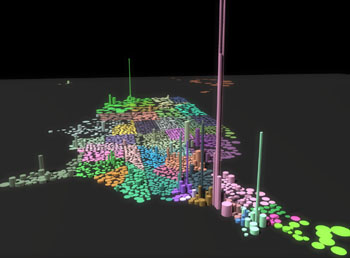
Right now, I have debugged the script, analyzed its output for missed counties, and am working at sanitizing the input data to avoid screwups. I hope to have a complete work in progress by the end of the weekend.
“Windy City” Enters Its First Screenwriting Competition
My first feature screenplay, “Windy City,” has been entered into the 2007 ASA International Screenplay Competition. The quarterfinalists will be announced by February 28, 2008, with the semifinalists coming out April 30 and the final winners being announced at the awards ceremony at the end of September, 2008.
As much as I dread (and typically fail) at self-promotion, it’s nice to be back on the contest scene. Æsop’s Council of Mice was my last animated film to play the film festival circuit, following the relative success of my award-winning debut Marboxian. Owing mainly to financial difficulties, I wasn’t able to do much with Mice, and I’ve had to focus on making a living since.
It’s been mentioned a few times here, but maybe it’s time to introduce the thing. Windy City is a classic city mouse/country mouse story written by someone who’s been both. It has airships and fantastic cities, natural and manmade disasters, and a whole laundry list of other exciting things. But that’s not why you’ll fall in love with it. The real movie is about a boy from the valley and a senator’s daughter from the city — Dan Assurbani and Nineve Sherrib — and how their lives meet and grow more and more complicated.
Windy City started life as a treatment six or seven years ago. At about this time last year, I dusted it off and set about cleaning it up. Somehow the treatment became a full first draft by April, and I had some friends with a bit of theatre experience over to do a cold readthrough. I sat on the lessons I learned from hearing it out loud, and the remaining issues I had with it, picked at it for the next few months as life got complicated again, and finally — in four days at a friend’s house in coastal Maine — burned through to a second draft in late August.
It’s been an interesting year. Wish Windy City luck.

